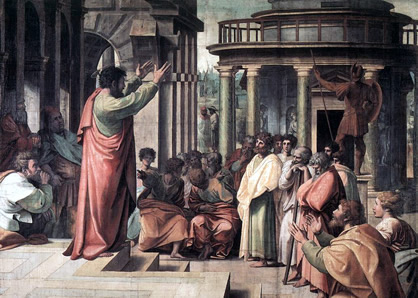Patmos Rev. 1:9
Location, Situation and Sites:
Location: About 40 miles southwest of Miletos in Asia Minor
(Modern Turkey) lies the Island of Patmos . It is one of the
Dodecanese (the twelve) and part of the Southern Sporades chain.
Situation: The island has an area of about 23 square miles.
It is about 10 miles long (north to south); about 6 miles wide (east
to west); and is about 37 miles around the island's periphery.
 It
is more properly three volcanic swells of land connected by two
small isthmuses, and appearing in a horseshoe shape. The highest
point is Hagios Elias, at over 850' ASL. The Chapel of St. John is
now located there.
It
is more properly three volcanic swells of land connected by two
small isthmuses, and appearing in a horseshoe shape. The highest
point is Hagios Elias, at over 850' ASL. The Chapel of St. John is
now located there.
Sites: The island has three villages but only two villages
visible from the port: Skala, at the east harbor; and Khora, which
rise up the now paved path at several miles distance. Another
village, Grikos, is a few miles west of Skala.
History and Mythology:
Early occupations: Some etymologists believe the name Patmos may be
a clue that the earliest people to inhabit the island were Carians,
who had a mountain called Latmos in their home territory. The
Carians were an ancient people of Asia Minor who worshipped Artemis
(later, Dianna). There is also evidence on the island of Dorian
occupation, and also Ionian settlement. It is from this
 period
that the island gained mythological identity.
period
that the island gained mythological identity.
Mythology: According to the legend, the hero Orestes was
pursued by the Furies who sought to punish him for the murder of
Clytemnestra, his mother. Orestes found the island, and took refuge
there.
Recorded history:
6th - 4th centuries BCE: a walled acropolis on the hill of Casteli
has been identified, along with the remains of the Temples of
Bacchus and Apollo, and what may be a hippodrome. The island fell
into decline by the period of Roman rule.
Roman: Tacitus Annals. (3. 68; 4.30; 15.71) state that the
island had become a penal colony for the political agitators. It had
been intentionally depopulated as the penal establishment grew. It
is in this period the New Testament records that St. John dwelt
here. In the text he is sent there because of "the Word of God and
testimony of Jesus", terms which are used later in the Book of
Revelation (6:9; 20:4) in reference to persecution. Eusebius records
that St. John was banished by Emperor Domitian in 95 CE, and
released 18 months later under Nerva (cp. Ecclesiastical History
III.18.1; 20.8-9).
4th - 9th centuries CE: Mainly Italian fisherman occupied the
island, and the ancient ruins were quarried for housing, etc.
were quarried for housing, etc.
1088 CE: A Christian monk of Nicea (in Bithynia) called
Christodoulos (slave of Christ) built St. John's cloister upon the
ruin of the Artemis Temple. Christodoulos had previously established
cloisters at both Kos and Leros, and came to Patmos with an
assignment from the Emperor of Byzantium to devote himself to quiet
reflection and study. His remains were placed in an open reliquary
beside the chapel of Christodoulos, but were eventually
deteriorating as people would "appropriate his holiness" by taking a
finger or toe from the body. The monks were eventually forced to put
the body in a marble sarcophogus.
15th - 19th centuries CE: The villages of the island sent for aid to
the Pope. They requested defensive help to ward off the oncoming
Turkish invasion in 1453. The Turks eventually took the island
(1523), but the Sultan gave a guarantee of self-administration.
While enjoying he self-administration, the island safeguarded its
Greek cultural heritage by initiating the Patmian School (founded
1713), an important Greek educational center. Two important Greeks,
Xanthos and Themelis, two of the founders of the secret society to
oust the Ottoman rule of Greek lands (Philiki Hetairia) were native
of this island. By the1830's, the island lost its autonomy and was
under direct Turkish rule.
20th century: In 1912, the island officially belonged to the
Italian Dodecanese, and remained under Italian occupation until
March 7, 1948, when it officially became a modern Greek island.

Sites for the modern visitor:
The Grotto of the Apocalypse: this traditional cave was fortified
into a monastery by Gregory of Caesarea in 17th century. The
frescoes to the left of the entrance portray the miracles and
travels of St. John the Evangelist, as written by Prochorus, a
supposed disciple. The fresco to the right of the entrance portrays
St. John's battle with the priest of Apollo at Patmos, who the story
says was called Kynops. St. John threw Kynops into the water of the
harbor at Skala, and Kynops turned to stone. The rock is still
pointed out as a local landmark in the harbor.
The Monastery of St. John and The Chapel of Virgin Mary: 12th
century frescoes were uncovered by 1956 earthquake that shattered
the 17th century coverings. The treasury of the monastery includes
jewels of Catherine the Great of Russia. The library of the
monastery includes over 900 manuscripts (325 parchment), 2000
codices and books, and 13,000 documents.
PLACE
REFERENCE
Amphipolis
Acts 17:1
Apollonia
Acts 17:1
Athens
Acts 17:15-16, 22; 18:1; 1 Thessalonians 3:1
Berea
Acts 17:10, 13: 20:4
Cenchrea
Acts 18:18, Romans 16:1
Coos (Kos)
Acts 21:1
Corinth
Acts 18:1; 19:1; 1 Corinthians 1:2; 2 Corinthians 1:1, 23; 2 Timothy
4:20
Cyprus
Acts 4:38; 11:19,20; 13:4; 15:39; 21:3,16; 27:4
Neapolis (Kavala) Acts 16:11
Patmos
Rev 1:9
Philippi Matthew 16:13; Mark 8:27; Acts 16:12, 22;
20:6; Philippians 1-4; 1 Thessalonians 2:2
Rhodes
Act 21:1
Thessalonica Acts
17:1. 11. 13; 27:2; Philippians 4:16: 1 and 2 Thessalonians; 2
Timothy 4:10


